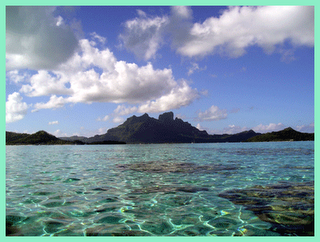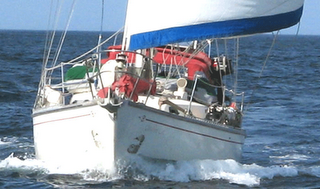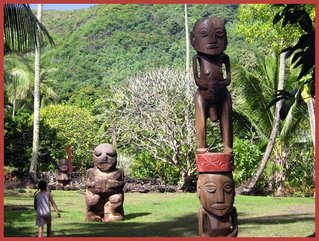French Polynesia
Ahe Atoll in the Tuomotos; Papeete in Tahiti; Opohuno Bay in Moorea; Bora-Bora.
Cheshire Cat left Daniel’s Bay on Nuku Hiva on 14th May just before lunch time heading for Tahiti, where we were to meet Sara, Caitlyn and Breanne at the end of the month. The forecast was for light winds so in an effort to economize on fuel for the first two days we found ourselves actively practicing times putting up and taking down our extravagantly sized and colorful spinnaker sail. Eventually the wind died altogether and we got bored with the repeated performance so we turned the engine on and and listened to the motor for the rest of the way.
On the third day we started to smell noxious odors emanating from the engine compartment and Mike discovered that a leaking hose in the area where a hose from the exhaust meets the cooling water on the engine. Rather than replace the whole hose he made a quick unilateral decision to cut an inch off the end. Mr. Murphy showed up again when Mike re-started the engine. It fired up beautifully but unfortunately we had no forward propulsion. The bolt holding the propeller shaft (the repair we had made in Panama) had sheared off. Mike climbed back into the hot engine compartment and replaced the useless bolt with our last remaining spare bolt. That old bolt had only lasted about 70 hours, giving us cause for some apprehension as to the worthiness of the current bolt and the repair.
Next day turned out to be equally hot as we motored westwards under a blue and cloudless sky. We took a shorter break from all the engine noise when we stopped because it was time to change the engine oil. The sea was smooth and absolutely calm without any breeze to ruffle the water. Peering over the side of the boat we could see fish swimming many feet below us. It was just too tempting so we jumped into the azure depths and indulged in a mid-ocean swim at the approximate location of 11 degrees 38 minutes south and 143 degrees 44 minutes west. Of course we also kept a sharp lookout – not wanting to have a memorable encounter and possibly find ourselves becoming a tasty lunchtime treat for an especially hungry shark that happened to be cruising in the vicinity. Yet another day of no wind and hot sunshine persuaded us to postpone our arrival in Tahiti and to call in at the atoll of Ahe for a few days instead.
The Tuamotos islands are known as The Dangerous Archipelago and we had listened with horror to toe curling stories of other yachts venturing among these low lying atolls. There is little to see in the way of land – every atoll is merely a small bump on the ocean surface, but each tiny island is protected by its own personal coral reef. Boats have to make their way through the narrow passes between sections of the corral reefs that adorn these tiny atolls. Only crashing white water waves breaking over the sections of coral that rise out over the water line mark the approximate position of a pass. Tales of contra-current rips flowing at five or six knots (faster than out little engine can push us along on a good day), plus whirling eddies to throw one off course and hidden underwater coral heads waiting to snare an unwary traveler made us more than a little nervous about our entry to an atoll.
Mike spotting the low lying atoll of Ahe
We arrived at our waypoint some distance away from Ahe in the northern Tuamotos group in the early evening, too late to go through the pass and find an anchorage, so we ‘hove to’ and settled down to enjoy the calm of a moon filled tropical night without sailing. Next morning we tried to calculate when we thought the tide would be least powerful. This was made slightly more difficult by the fact that neither of our two tide programs agreed with each other, and the calculation of moon and tide only added another figure to the equation. Eventually we opted to go in at 7.30 am and made way towards the final approach with some apprehension. As we entered the channel we watched the instrument panel – our speed suddenly went from a nice manageable sedate 3 knots to a heady 6 knots and suddenly we knew we had no alternative but to keep on going and steer as best we could – there was no possibility of our turning the boat back in the narrow gap between the reefs. We held our breath and searched the water for hazards, (avoiding a small whirlpool off to starboard,) until the instruments showed we were regaining our more leisurely comfortable pace of three knots. Suddenly we were through – safe and sound in the lagoon! All we had to do now was navigate across the lagoon, watching for underwater coral heads which can rip the sole out of a boat in a heartbeat. One of us was standing high in the rigging (the new rat lines I made in Galapagos) spotting the treacherous coral, and we were sure to travel when the sun was high in the sky. This particular atoll had a very well buoyed channel, so we had no real fears. Our anchor was soon down and we were greeted by several friends in a small sheltered area not far from the village.
Ahe is a pearl farming area and we noticed numerous small marker buoys in shallow water all the way out across the lagoon. We found out that the pearls are grown in oyster shells which are hung on lines from those floating balls. Every individual oyster is impregnated with a special seed by skilled employees working by hand and the final pearl size is dependent on the size of that seed. The oysters are left to mature for a year or two and the thickness of the pearl and the luminescent color dictates the value of the pearl. Various pearl types are baroque, ringed, tear drop and round pearls. They come in a range of browns, greens, rainbow, black, blue and purplish, and vary in value enormously, so it is difficult to make an uninformed eyeball judgment of value. I read that on can get them x-rayed to ensure that they are good quality.
Leaving Ahe on 23rd we motored back across the lagoon, encountering a strong breeze and some bouncy waves forming on the hitherto peaceful water. Exiting the pass proved to be just as hair-raising as the entrance; we approached with care and somewhat dry mouths, tried to maintain a cautious but manageable speed and once again found ourselves being swept along at an vigorous six knot plus. Once outside the pass, we raised sail and headed west, bound for the fabled island of Tahiti.
We could see the island of Moorea from our anchorage in Papeete
This was supposed to be an easy down wind two day passage – just a short hop from one set of islands (the Tuamotos) to another (The Society Islands). Once again this year’s unpredictable weather caught us off guard. We soon found ourselves with a fully reefed mainsail (how I wish we had a third reef) and our large genoa partially reefed. The wind and seas escalated and when we listened to the morning net that other boats in the same area were getting lashed by rain and squalls of up to 60 knots of wind. Not nice.
All too soon we were buffeted by winds of up to 40 knots, with impressively lumpy seas to match, some nasty squalls lasting for over an hour at a time. Torrential rain and whiteout conditions reduced visibility and we longed for accurate radar. It was impossible to see any other vessel. At the back of the cockpit there is little protection from the wind or the rain and we hand steered off the wind through the worst of the squalls. Soon we were drenched and uncomfortable from the lashing rain and the spray flying off the waves which insisted on climbing up the sides of the boat at frequent intervals. Neither of us got more than a few minutes sleep that night. When it was dark and a particularly strong gust of wind hit us we shortened the foresail only to realize the next morning that it was ripped. We could only hope we could mend it later. On the chart Tahiti looked very close on the afternoon of the second day out but the grey and cloudy heavily overcast skies and driving rain made it impossible to see the island even though the mountains are quite high. We were tired and chilled even though it is much easier to deal with the rain in the tropical temperatures. Eventually the somber clouds parted and we were granted small glimpses of our destination. As the afternoon progressed so did the weather, gradually improving until we were able to relax and look forward to getting into port.
Old Murphy hadn’t finished with us however. Suddenly the engine overheated and we had to shut it down in a hurry. Mike, tired as he was, investigated the engine compartment yet again and established that this time the fan belt had broken. What a relief – a comparatively minor problem, easily fixed! As we were approaching the reef pass at Papeete harbor, the engine began to overheat again, and we had a decision to make. Should we continue through the pass and to an anchorage taking advantage of the daylight that we had left and hoping that the engine would be ok for the rest of the time, or should we lay a hull outside the pass all night and make our entry next morning? Believe me – the temptation to keep on going was considerable, as we were both miserably tired and anxious to get into shelter and safe harbor. We made the unwelcome choice to heave to, staying outside the pass until the morning. Grumpily settled into a watch routine for the third night, but managed to get a few hours much needed and very welcome sleep over the next few uneventful hours, making the whole world look a lot better next day.
The engine sprang to life like a good ‘un when we fired it up before sunrise and we had no holdups going through the wide reef pass into the main harbor of Papeete. We motored past the airport to the Maeva Beach area and soon had the anchor down near Marina Tiana. It was generally agreed later amongst several seasoned cruisers that the short passage from the Tuamotos had been a nasty bit of work.
Sara and Caitlyn by a waterfall

There are five groups of islands in French Polynesia – the Islands of the Marquesas, the Tuamotos Atolls, the Society Islands, the Austral islands and the Gambier Islands. Tahiti is the largest island and the capital and administrative centre is Papeete. The weather is wonderful, except this year there seems to be more rain than usual. April to November is winter here below the equator, but the temperatures are wonderful and stable in the low 30’s. Apparently it is an el Nina year, one effect being enhanced trade winds. These winds are more challenging than we expected. There seem to be more lows to suck the winds away from us and more highs to mix with the ITCZ and create havoc. The passage across the Pacific is dubbed ‘the coconut milk run’, but for us it is turning out to be the ‘milk shake run’!
French Polynesia is heavily subsidized by France and the standard of living seems extraordinarily high in most places. (The French used some of the atolls to test nuclear weapons, and they are still suffering the political and probably heavy social repercussions). We found the prices in the shops and restaurants larcenously high, with what seems to be the equivalent of European prices for everything. This definitely puts a bit of a strain on our budget and is a massive shock following our South American experiences. Some of the hotels reputedly charged 2,000 US dollars per room per night, this excluding food, drinks and entertainment Local internet for us is 24.00 an hour – and is abysmally slow to put it mildly.
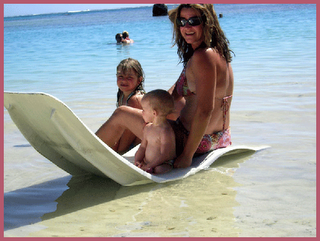
Sara arrived with the children as planned from Canada and they took a few days to recover from their long flights from Toronto. Soon, however, they settled into their strange new environment on the boat and we explored Tahiti by car, making stops at the museum of Tahiti and the Lagoonarium. We visited the three Faarumai waterfalls, the tropical jungle of the Vaipu Valley, stopped at some of the beautiful breaches and pristine swimming pools in some exclusive hotels. The vegetation is very lush and there are all manner of fragrant and tropical flowers growing abundantly; hibiscus, orchids, flamboyant, frangipani, ginger flowers, and the popular fragrant Tiare Tahiti better known as gardenia. Many people wear a flower behind an ear as a matter of course (even the men) and garlands worn as hats or necklaces are commonplace.
All too soon we were buffeted by winds of up to 40 knots, with impressively lumpy seas to match, some nasty squalls lasting for over an hour at a time. Torrential rain and whiteout conditions reduced visibility and we longed for accurate radar. It was impossible to see any other vessel. At the back of the cockpit there is little protection from the wind or the rain and we hand steered off the wind through the worst of the squalls. Soon we were drenched and uncomfortable from the lashing rain and the spray flying off the waves which insisted on climbing up the sides of the boat at frequent intervals. Neither of us got more than a few minutes sleep that night. When it was dark and a particularly strong gust of wind hit us we shortened the foresail only to realize the next morning that it was ripped. We could only hope we could mend it later. On the chart Tahiti looked very close on the afternoon of the second day out but the grey and cloudy heavily overcast skies and driving rain made it impossible to see the island even though the mountains are quite high. We were tired and chilled even though it is much easier to deal with the rain in the tropical temperatures. Eventually the somber clouds parted and we were granted small glimpses of our destination. As the afternoon progressed so did the weather, gradually improving until we were able to relax and look forward to getting into port.
Old Murphy hadn’t finished with us however. Suddenly the engine overheated and we had to shut it down in a hurry. Mike, tired as he was, investigated the engine compartment yet again and established that this time the fan belt had broken. What a relief – a comparatively minor problem, easily fixed! As we were approaching the reef pass at Papeete harbor, the engine began to overheat again, and we had a decision to make. Should we continue through the pass and to an anchorage taking advantage of the daylight that we had left and hoping that the engine would be ok for the rest of the time, or should we lay a hull outside the pass all night and make our entry next morning? Believe me – the temptation to keep on going was considerable, as we were both miserably tired and anxious to get into shelter and safe harbor. We made the unwelcome choice to heave to, staying outside the pass until the morning. Grumpily settled into a watch routine for the third night, but managed to get a few hours much needed and very welcome sleep over the next few uneventful hours, making the whole world look a lot better next day.
The engine sprang to life like a good ‘un when we fired it up before sunrise and we had no holdups going through the wide reef pass into the main harbor of Papeete. We motored past the airport to the Maeva Beach area and soon had the anchor down near Marina Tiana. It was generally agreed later amongst several seasoned cruisers that the short passage from the Tuamotos had been a nasty bit of work.
Sara and Caitlyn by a waterfall

There are five groups of islands in French Polynesia – the Islands of the Marquesas, the Tuamotos Atolls, the Society Islands, the Austral islands and the Gambier Islands. Tahiti is the largest island and the capital and administrative centre is Papeete. The weather is wonderful, except this year there seems to be more rain than usual. April to November is winter here below the equator, but the temperatures are wonderful and stable in the low 30’s. Apparently it is an el Nina year, one effect being enhanced trade winds. These winds are more challenging than we expected. There seem to be more lows to suck the winds away from us and more highs to mix with the ITCZ and create havoc. The passage across the Pacific is dubbed ‘the coconut milk run’, but for us it is turning out to be the ‘milk shake run’!
French Polynesia is heavily subsidized by France and the standard of living seems extraordinarily high in most places. (The French used some of the atolls to test nuclear weapons, and they are still suffering the political and probably heavy social repercussions). We found the prices in the shops and restaurants larcenously high, with what seems to be the equivalent of European prices for everything. This definitely puts a bit of a strain on our budget and is a massive shock following our South American experiences. Some of the hotels reputedly charged 2,000 US dollars per room per night, this excluding food, drinks and entertainment Local internet for us is 24.00 an hour – and is abysmally slow to put it mildly.
Sara and the children loved the beaches

Sara arrived with the children as planned from Canada and they took a few days to recover from their long flights from Toronto. Soon, however, they settled into their strange new environment on the boat and we explored Tahiti by car, making stops at the museum of Tahiti and the Lagoonarium. We visited the three Faarumai waterfalls, the tropical jungle of the Vaipu Valley, stopped at some of the beautiful breaches and pristine swimming pools in some exclusive hotels. The vegetation is very lush and there are all manner of fragrant and tropical flowers growing abundantly; hibiscus, orchids, flamboyant, frangipani, ginger flowers, and the popular fragrant Tiare Tahiti better known as gardenia. Many people wear a flower behind an ear as a matter of course (even the men) and garlands worn as hats or necklaces are commonplace.
Sara bought a beautiful incandescent green pearl - a once in a lifetime extravagance to remind her of her tropical adventure. We had a brief look at the very interesting market area, where there were the usual fruits and vegetables as well as meat and fish area, as well as a colorful a varied selection of local arts and crafts. Here we saw the lovely hand-woven baskets, necklaces made from carved shells, colorful parea, wood carvings, pearl jewelry and other attractive items. We also found the best lunch deal in town - a baguette filled with a choice of salads, meats and cheeses. A salad in a restaurant usually cost about 15.00 to 20.00, so we were very pleased to have this inexpensive treat for a mere 2.00.
Polynesian Dance
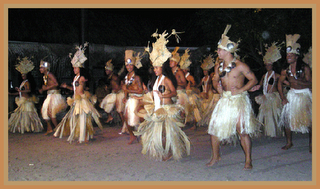
The Polynesian dancing here is everything and more that one has read and heard about. Each performance we saw consisted of several acts which necessitated changes of costume and in some cases props. Every show we saw was at least 45 minutes long. The performers have amazing stamina and really seemed to enjoy themselves, laughing and smiling at each other as well as sending some very inviting glances Polynesian style out into the watching crowd! The performers are generally quite young, between sixteen and thirty years old and they are truly athletes as well as dancers. Many performers have tattoos; the girls on the small of their backs, and the guys on legs, torso and even occasionally on their faces.
Particular striking displays resembling traditional Polynesian dances. In the war dance the men dance a Paoti step – raising their heels and bending their knees and at the same time bringing their knees together extremely rapidly without moving their torso. (try it – it’s hard!) They whoop and growl, leap and punch the air with wild flourishes in an alarming and intimidating routine. There is no written language here, so storytelling is vital and an Aparima is a story told in dance. At one hotel we saw a ‘play’ about the arrival of the good ship Bounty (presumably before the mutiny) This dance story depicted the arrival of these strange white men, their enticement by the local vahine (girls), a conversion to Christianity and a wedding all performed by the local Tahiti Ballet Troupe. The girls are very attractive with their undulating hips and seductive arm movements in the time-honored ‘hula’ fashion.
The Amazing Fire Dancers at the Tikki Village

We saw a very special fire dance at the Tikki village, an excellent exhibition that included about 12 very athletic young men dancing with fire sticks in a superb choreographed dance. Part of this dance also included a story which incorporated the crowning of a king and a wedding. The last dance performance we saw was in Bora-Bora after Sara had left, and was part of the July 14th Bastille Day celebrations. The islands each have very popular and spirited dance competitions. We saw a large troop of about 60 performers tell a story about a traditional fishing activity which included canoes, wars, a king, a goddess and a whole lot of images that we didn’t fully comprehend. It was every bit as good as the professional dances I saw and it was very popular with the locals who attended in full force.
After a few days in Papeete we planned to go to the next island, but when we left the shelter of the lagoon and land we encountered fairly high winds and waves and wisely decided to turn back just as all the visitors turned green! A few days later it was a lot calmer and we sailed for a few short hours to Moorea where we anchored just off the reef in clear shallow turquoise water and where we could see the sandy bottom and watch the fish and an occasional turtle go by. There was even a small spotted eagle ray gliding around our area.

Moorea is just 12 miles from Tahiti, and boasts four mountains, the tallest being 3959 ft and the one just behind our anchorage being Moua Roa which was featured in the film Bali Hai. The island is tiny – 37 miles around, with two sheltered bays to anchor in and a beautiful lagoon protected by the coral reef. Some cruisers have bicycles on board and were able to peddle around to see the whole island. We contented ourselves with less energetic exercise and snorkeled and swam in the warm waters. Caitlyn was treated to a special chance to swim with a dolphin at a nearby hotel where they have a dolphin centre.
After a few days in Papeete we planned to go to the next island, but when we left the shelter of the lagoon and land we encountered fairly high winds and waves and wisely decided to turn back just as all the visitors turned green! A few days later it was a lot calmer and we sailed for a few short hours to Moorea where we anchored just off the reef in clear shallow turquoise water and where we could see the sandy bottom and watch the fish and an occasional turtle go by. There was even a small spotted eagle ray gliding around our area.
Caitlyn enjoyed her session with the dolphin and the dolphin loved the attention from the children

Moorea is just 12 miles from Tahiti, and boasts four mountains, the tallest being 3959 ft and the one just behind our anchorage being Moua Roa which was featured in the film Bali Hai. The island is tiny – 37 miles around, with two sheltered bays to anchor in and a beautiful lagoon protected by the coral reef. Some cruisers have bicycles on board and were able to peddle around to see the whole island. We contented ourselves with less energetic exercise and snorkeled and swam in the warm waters. Caitlyn was treated to a special chance to swim with a dolphin at a nearby hotel where they have a dolphin centre.
An Unforgettable Experience - Swimming with the Tahitian Rays

We discovered a spot where we could swim with the rays – an extraordinary experience and on e that will stay in our memory banks forever. We motored to the sandy ledge inside the lagoon in our dinghies, and jumping in the warm water stood on the sand in waist high bath warm water.
About 10 or 12 quite large rays swam over to investigate us. They cruised all around and under us, allowing us to stroke them - they turn out to be very soft to touch, not at all fishy or scaly although their tails are brittle. On occasion some even swam right up along our bodies almost giving a hug with their wings! It was an amazing experience to be able to get so close to a creature that we would normally only see in an enclosed aquarium environment. Tour boats go there with visitors and the guides feed them fish scraps, so they expect to have people around and get quite greedy. In addition there are some black tipped reef sharks that like to share the fishy feast; we saw several of those as well.
Bora-Bora is part of the Leeward Islands; it is an atoll covering 38 sq km. It has two mountains, Mt Otema at 2400 ft and Mt Pahia at 2170 ft high. It is just as beautiful as we heard – the “Pearl of the S0ocity Islands” It is surrounded by a large lagoon which is protected by the reef and there is only one way in – through the Teavaniu Pass. I think the island was pretty much untouched after the missionaries arrived in the early 1800’s, but no doubt the whole island underwent huge changes when 6,000 US troops arrived for four brief years during World War II. There seems to be about thirteen expensive hotels and consequently lots of tourists. The boat people aren’t really welcomed here I don’t think. One was asked to leave a small deserted island or motu where they were walking; another was asked for a fee of 150.00 US to use hotel facilities. Others have been asked to out of an anchorage and beached near a hotel because a “star” was staying Cruise ships of all sizes visit, and the lagoon is a constant bustle of tour boats and water taxis criss-crossing from the main island to the motus (small islands) in the lagoon. Viatape is the main town or rather village, where there is a post office, a couple of banks, several pearl shops and not much else. There are two small markets so we don’t go without the necessities of life (fresh baguettes and beer!) .
Bora-Bora Yacht Club where Mike enjoyed an occasional beer
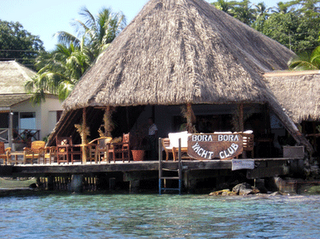
Our first few restless nights after our arrival were spent securely tied on a mooring ball near Bloody Mary’s restaurant as the winds were howling and the water over 24 meters deep, deeper than we like to anchor in for safety. The restaurant has a board showing some of the names of celebrities that have visited – I can recognize lots on the one side – the old names like Marlon Brando, Raquel Welch, Buzz Aldrin and Stephan Grapelli. On the other side the only name I was familiar with was Johnny Dep! Soon we moved off to anchor on the reef in a nice comfortable 10 feet of clear water.
We wanted to find the play ground of the big manta rays we have heard about. Unfortunately we discover that nearly all the big rays have gone, disruption from hotel construction has disturbed them and they no longer cruise inside the lagoon. We were very fortunate to find one cruising near our boat. It must have been huge as we could see it reasonably clearly in about 30 feet of water. Snorkeling was disappointing as the coral is dead, as apparently a hurricane came through a few years ago and devastated the lagoon. And last year the water warmed up so much that all the coral died and countless reef fish expired. Such a terrible shame to see such loss and devastation. Luckily we did see sting rays and several gorgeous spotted eagle rays browsing right under our boat. And there is also a spot that all the tour boats visit where we went snorkeling with bread to feed the fish. This was quite exciting because as soon as you jump into the water hundreds of little fish swim right up to you looking for a bread handout! I’ve never swum in an aquarium before!!
Our water maker membrane has arrived courtesy of PUR and we at last have fresh water. Time is passing and although the weather isn’t the best our three months cruising permit is almost up here. Our next stop will be the tiny island of Suwarrow and from there to Western Samoa.
Goodbye Beautiful Bora-Bora
